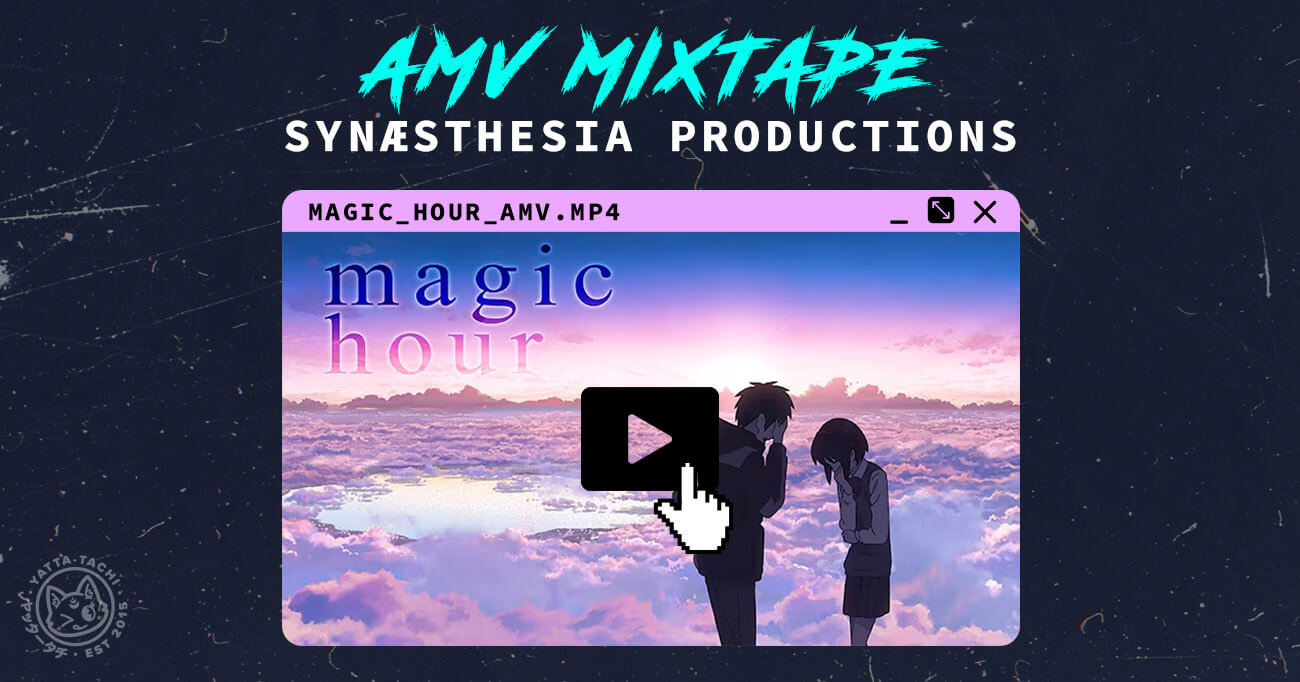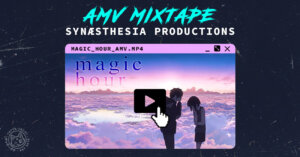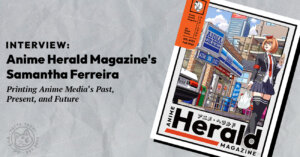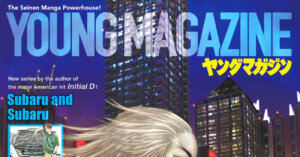I love anime music videos. You might already know this, since I previously wrote an AMV starter kit for the site. But I’ve been asking myself questions lately about the medium. How did my favorite editors get started? What does it mean to edit a video? What place do AMVs have in an increasingly corporatized anime fandom? Are we living in a dry period for the format, or a new golden age?
This is AMV MixTape, an ongoing feature where I speak to an AMV editor about five of their past videos. For our first installment, I spoke with SynæsthesiaAMV at Synæsthesia Productions. Syn is a prolific video editor who has made over 60 videos since 2018. He loves Kyoto Animation, 1980s aesthetics, and the band Snail’s House.
Origin Story
ADAM WESCOTT: When did you first get into AMVs?
SYN: I first discovered them in high school during the late 90s. I’d always been a fan of music videos, so when I saw that people were making their own videos with anime, I thought that was really cool. At the time, though, it was hard to get into. In the late ’90s and early 2000s, the technology for video editing wasn’t available. Then I went to college in 2001 and stopped watching anime because I didn’t have time for it.
Then I discovered Studio Ghibli films in 2015. I had only watched Princess Mononoke up until then. But I watched Totoro and Kiki, and thought, “Man, this shit’s good.” Now I’m watching 18 shows this season. There are so many good shows coming out right now.
Ever since I started listening to music in my teens, my mind starts going into music video mode, especially when I’m listening to songs that I like. So in 2017, when I decided that I wanted to start making AMVs, I started looking to buy a computer. My cousin, who’s a big computer nerd, said to me, “Dude, I’ll just build you a computer for free.” He preloaded it with Adobe Premiere and After Effects. Premiere I found to be really easy, so I looked up some tutorial videos on YouTube and did a couple of short test videos.
WESCOTT: Were you influenced by any video editors?
SYN: Back in high school, I didn’t pay much attention to the editors making the AMVs. When I got back into them, though, eight or nine years ago, there were a few editors who inspired me. nekokitkat is still a big influence on my editing. Most of her videos are just raw edits, so she has a good eye for flow, and good visual storytelling. I watched her videos a lot when I first started out.
neko’s also got her own video contest, “nekokitcontest,” that I’m making a video for. She’s a fan of longer videos like I am. I have an eight minute video planned. Which wouldn’t be my longest AMV; that one came out this year, and is 11 minutes.
WESCOTT: Going into vivafringe territory, huh.
SYN: That guy is probably my favorite video editor! I’ve met him in person at AWA; he’s a really cool dude. His videos are all multisource, but each feels like one complete video. I hope that I one day make a video of his caliber.
Magic Hour
SYN: In 2018, I edited my first video, “Magic Hour.” I used Your Name, because that movie was fresh on my mind, and set it to “The Birth and Death of the Day,” an instrumental track by the band Explosions in the Sky. Have you seen it?
WESCOTT: When I looked on your YouTube channel, I could only find your revised version of the video. I watched that one, but I haven’t seen the original.
SYN: I did a 4K upscale and reedited the entire thing. It’s basically the same video, though. The biggest difference is the video quality. When I first started, I had never done any video editing before. Using that Explosions in the Sky song was ambitious because it is seven minutes long. But it was in my head, and I was picturing it with Your Name. So I thought I would give it a try.
WESCOTT: In the revised version, I thought it was interesting how much focus you put on the backgrounds. You really cut down on the film’s narrative to let its environments speak for themselves.
SYN: That mirrors the original vid, too. I loved the backgrounds in the movie, so I wanted to put them in the video. Another thing I improved on in the revised version is the internal flow. Doing more match cuts, for instance. Stuff that I didn’t know about when I started out, but learned in the next five years.
I was proud of the end product. It only took me two weeks! The original took me an entire month. It takes me much less time now to make a video. I do them in phases. The first phase is collecting the materials I need, like video and audio. Then I start clipping them. Once I start throwing stuff on a timeline, I only do a couple seconds at a time. I came back a half hour later to look at them.
Gradually, I get into the video once I know the vision. Sometimes I’ll take a scene, throw it on one part of the song, and see if it works. Then I’ll throw it on a different part to see if it works there, too. I mix and match to see what fits.
Running in the Night
WESCOTT: The next video of yours I wanted to talk about is “Running in the Night.” Since you brought up nekokitkat earlier, I wanted to mention that she also did an 80s-influenced video in 2020 called “Back to Life.”
SYN: It’s the same singer, Ollie Wide. “Back to Life” put the idea in my head to make a retro 80s nostalgia video.
WESCOTT: There’s a lot in “Running in the Night” from Brand New Animal‘s incredible ending sequence. Which makes sense, because it’s great. But it’s mixed with footage from the rest of the series as well, particularly the first episode. Was it challenging to make the footage fit together?
SYN: Not really, actually. The entire show for me, especially those earlier episodes, already had an 80s vibe. I don’t know what Studio Trigger did, or what effect they used. Maybe it was the color choices. I just remember watching the first two episodes and thinking, “I’ve gotta do some 80s vibe with this show.” To motivate myself to finish it, I told myself, “I won’t finish the show until I finish the video.”
I was super proud of it. I also downloaded a bunch of free 80s VHS overlays that I drew in there.
WESCOTT: What’s the process for overlays?
SYN: Like Photoshop, Premiere has video layers. You can have as many tracks as you want and stack them on top of each other. So you can take what looks like VHS static, overlay it above a track and change the opacity so it’s not just black.
I found a free 80s retro video overlay with a neon triangle and circle. It was just one image, so I added an effect to it where I could rotate it. Then I added multiple layers, zooming closer and closer as you went up. I synced that with the synth parts.
WESCOTT: It reminds me of Trigger director Hiroyuki Imaishi, who loves simple shapes. His movie PROMARE is all about “what if you had a triangle and it became big!”
SYN: I’m a huge Imaishi fan. I threw the effects in there because they looked good and synced up well with the music. But “Running With the Night” is my most-viewed video, or at least my most-viewed AMV on YouTube. It has 14,000 views.
My Everyday Vibes
WESCOTT: Since you said that vivafringe is a favorite of yours, I can see his influence on your video “My Everyday Vibes.” It’s a conceptual video about match cuts.
SYN: “My Everyday Vibes” took a while for me to figure out. I knew that I wanted to make a video with “Vivid Green” by the band Snail’s House. I also knew that I wanted to use something from Kyoto Animation, which is my favorite anime studio. An early draft was a multisource video using various KyoAni shows. But I put it on the backburner for a while.
When I came back, it was right after rewatching Nichijou. I thought, “Why don’t I just make it a Nichijou video?” It just matched the vibe so well. The video starts with the line, “The lives we live are a succession of miracles, day after day.” That’s an actual line from the anime, and it’s the emotional core of the show. I wanted to use “My Everyday Vibes” to highlight that.
WESCOTT: I haven’t seen Nichijou yet. But when I think of the series, I remember the explosive skits I’ve seen online, like Mio flipping the goat or shooting a laser beam out of her mouth after a dog bites her.
SYN: That’s how I got into the show, too. When I did, though, I realized, “Nichijou has that, but it has a lot of quiet scenes where people live their daily lives, too.” If you haven’t seen it, I highly recommend it.
WESCOTT: You can definitely see that quiet, dreamlike side in “My Everyday Vibes.” You can see it in KyoAni’s more recent series City the Animation as well.
SYN: I’m loving City the Animation! So far, I might like it even more than Nichijou. I already have a Snail’s House video planned for it. Another instrumental, and a spiritual successor to “My Everyday Vibes.” Maybe I’ll get to it next year.
Knight Saber City
SYN: I made “Knight Saber City” for the AWA Accolades contest. It was my first time entering, so I wanted the video to be the best that I had ever made. So I decided, “I’ll spend a full year working on it.” At first I spent a month, then shelved it for a couple more months, then went back to it. It took nine months in all, and turned out better than I expected. I’m still super proud of it.
WESCOTT: Did you have The Protomen in mind from the start?
SYN: I remember first hearing “This City Made Us,” and thinking, “This is one of the greatest rock songs I’ve ever heard. How is this band not bigger?” I knew I wanted to use a show with an 80s vibe, or one that was made in the 80s. When I was looking up older anime, I remembered Bubblegum Crisis. I’d watched it back in my teens, so I didn’t remember much. Three episodes into my rewatch, I thought, “Yep, this is gonna hit.”
“Knight Saber City” is one of the first times that I thought of the title before finishing the video. Usually I’ll think up a title after I finish it. I’m terrible at coming up with them. Usually I’ll use the song name, because I’m making the video for the song most of the time, anyway.
WESCOTT: The layers, visual effects, and transitions in this video fit more smoothly together than in some of your earlier ones.
SYN: I rewatch my videos a lot, mainly because I make them for myself. When I do, I have a critical eye. “I could have made this transition smoother,” or “I wish I used this scene instead.” I took all of what I learned and put it into editing “Knight Saber City,” because I wanted it to look as perfect as it could.
When I was editing this video, I experimented by splitting up the audio into different sections and color coding them in Premiere. The blue section is the intro, which I knew would be one of the most important parts of the video. I worked hard on that part, rearranging scenes to make it look just right.
WESCOTT: “This City Made Us” does have a really long lead-up. It takes a minute or so before it kicks off.
SYN: Then you have the magenta section which is the climax, and for me the most important part of the song. When I do videos, I don’t start from the very beginning. I pick key moments from the song and make sure those parts look right first. Then I build the video from there. You can’t make it look perfect throughout. You decide what parts will have the most impact. So you edit those first, make them look great, and build around that.
Fantasy
WESCOTT: Let’s talk about your Fantasy trilogy of AMVs, which use three songs from M83’s album “Fantasy” to cover Leda: The Fantastic Adventure of Yohko.
SYN: That was not my plan starting out. I made the first video, “Fantasy,” because I wanted to do something with that song and that OVA. But when I was almost done making the video, I realized that I’d only used a third of the source. So I thought, “Why not do a continuation?” I went for it and decided to make a trilogy of videos.
I made “Amnesia” and “Us and the Rest” with the same mindset that I had when making “Fantasy.” I didn’t want to retell the original anime. I wanted to use nonlinear storytelling, particularly for “Us and the Rest.” With my limited video source, I had to go back and use some earlier scenes I skipped over before. But it was a fun project. I want to do another one of these at some point.
WESCOTT: Ever since The Lord of the Rings, every fantasy project has to be a trilogy, whether it should be or not. So your “Fantasy” trilogy fits in quite well!
What you said also hits at one of the key struggles of AMV making. How do you get at the essence of a work without simply recreating it? Sure, it’s fun to set something to music, but then you could also just watch the original. While watching “Fantasy,” as somebody who hadn’t seen Leda: The Fantastic Adventure of Yohko, I had a hard time picking apart what came from the source and what came from you. But I loved the “To Be Continued” stinger at the end as this cheeky acknowledgement of further adventures to come.
SYN: For me, the music always dictates how the video looks. The trick is to keep a narrative that follows the music but is also understandable. That was definitely a big weakness for me starting out. I used to be the vibes AMV editor, which is still true. But apparently I’ve overcome this weakness recently, because my BLOOD FOR THE BLOOD GOD video won multiple storytelling awards. That blew my mind!
冬 WINTER
WESCOTT: So you made four Ochibi-san AMVs set to Snail’s House songs, each themed after a season. Did you start with the source material or with the idea of doing AMVs based on four seasons?
SYN: I’ve always been a seasonal kind of person. If you look into my back catalog, you’ll see that I put out my darker videos in October and November. Earlier during the year, in spring and summer, is when I have my more cheery videos.
Ochibi-san is not a seasonal anime. But throughout each episode, they focus on certain seasons like summer or winter. Watching that, I thought about doing four seasonal videos, and my mind immediately went to Snail’s House.
WESCOTT: Maybe you should change your name to Snail’s House Productions.
SYN: I am definitely the #1 Snail’s House fan in AMV circles.
I cut up the source footage into different seasonal parts, then broke them into subcategories and color-coded them. I had different tabs with the other seasons, too. For me, the hardest part about video editing is organizing everything. That’s why I make that my first phase. I edit by feel, so the less I have to think about it, the easier it is.
WESCOTT: Do you have any memories of working on the Winter video in particular?
SYN: In Ochibi-san, there are fewer winter scenes than any other season. I started with a different and long song, but then realized, “I don’t think that I’m going to have enough footage for this.” So I picked another song that was a lot shorter. I even ended up shortening it further, which I hate having to do. It always sounds like the song was cut off.
WESCOTT: It sounded fine to me, but I’m very new to Snail’s House.
SYN: Only the true Snailheads will know.
WESCOTT: Another thing I noticed is that while you cut around the audio snaps in “Winter” like you do in “My Everyday Vibes.” It felt to me like you were trying to ease off the sync and let the footage breathe more.
SYN: That’s another thing I’ve been trying to be aware of. When I was starting to edit, I would try and sync every single beat. I spent three months on my third video syncing the shit out of it. But I don’t watch that video anymore, because the hard syncs there are very distracting and disrupt the flow. Ever since then I’ve been trying not to do too much sync and let the video breathe more.
I might like to do a do-over of that video like with “Magic Hour,” but with another source. I just want to have a good video with that song.
Bookend
WESCOTT: Before we go, I wanted to ask: Is there a video you watched recently that inspired you?
SYN: “american anxiety” by SadSack and chlorite. The editing is so good. It also uses a song that I really like by the band Magdalena Bay. For me, if you use a song that I love, I’m probably going to love your video.
I make AMVs in the first place because I have very niche music tastes. If nobody else is going to make these videos, it might as well be me.

Featured Sponsor - JAST
The sweetest romance and the darkest corruption, the biggest titles and the indie darlings; for visual novels and eroge, there's nowhere better.
Big thank you to our supporters
From their continous support, we are able to pay our team for their time and hard work on the site.
We have a Thank-You page dedicated to those who help us continue the work that we’ve been doing.
See our thank you page





